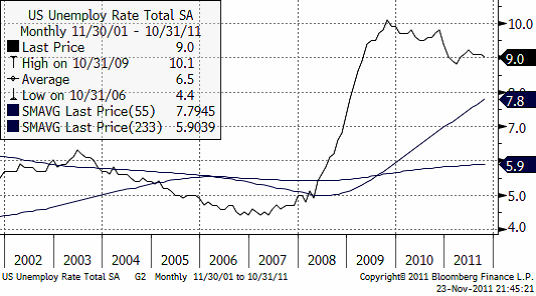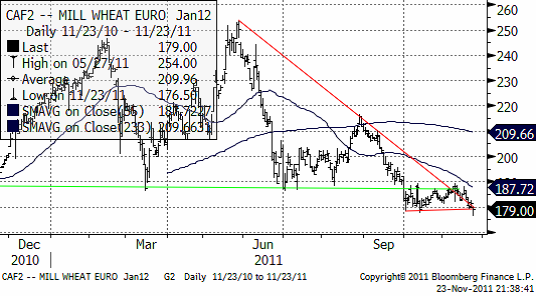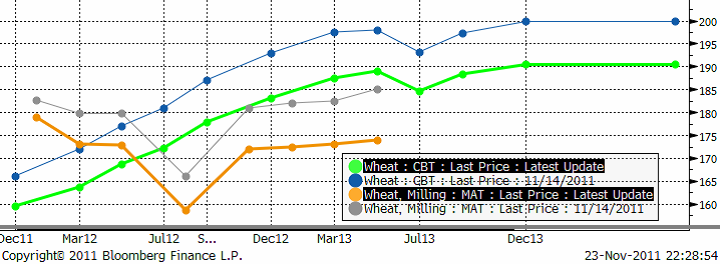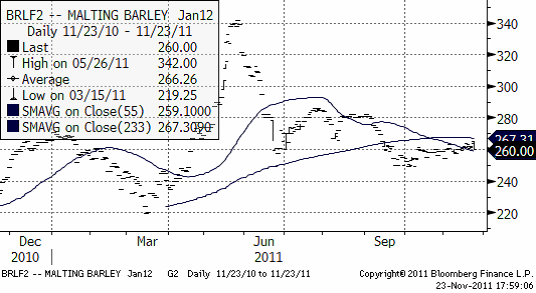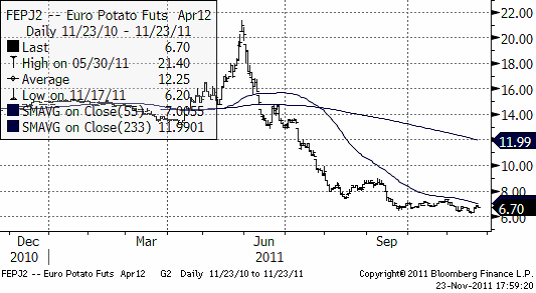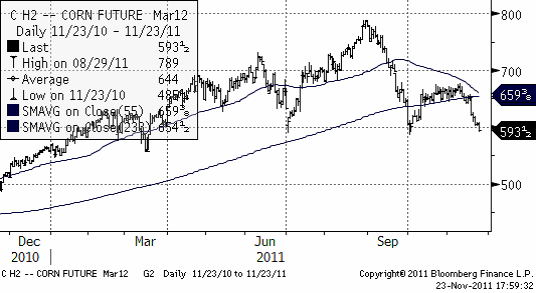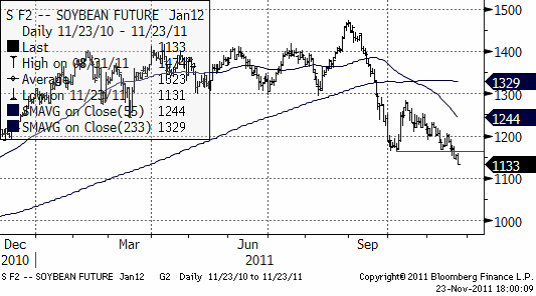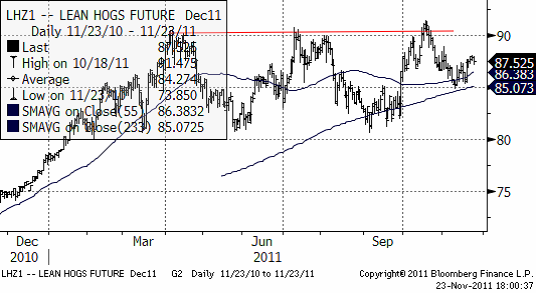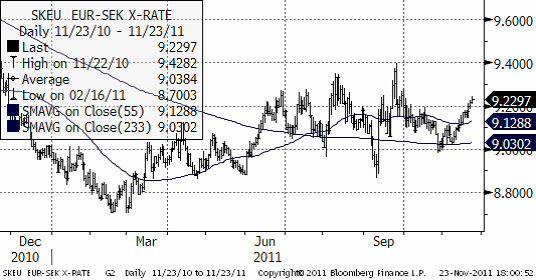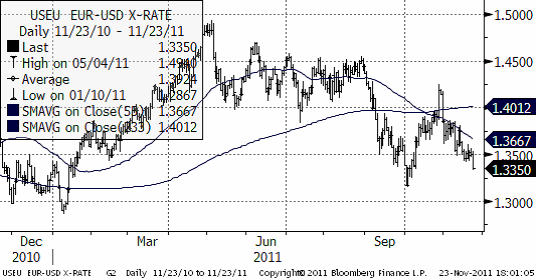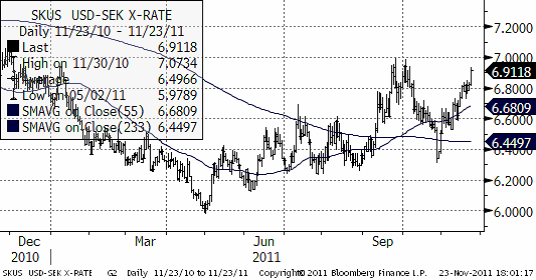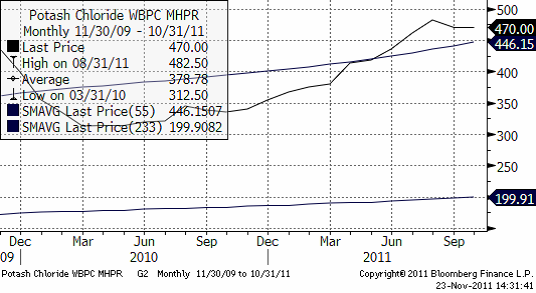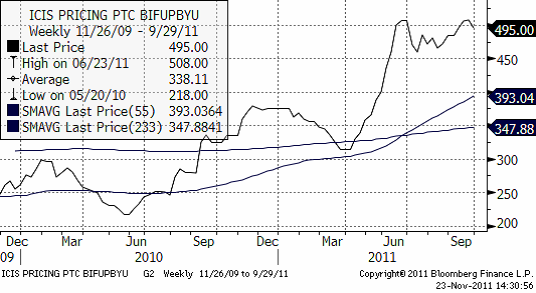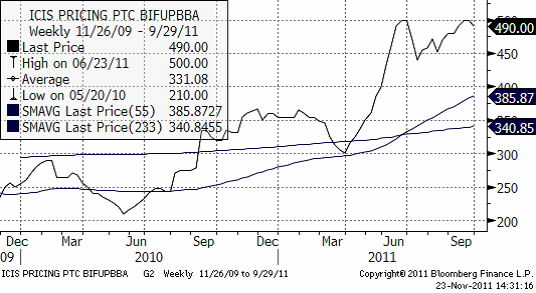Analys
SEB – Jordbruksprodukter, vecka 47
 Vete, majs och sojabönor har precis brutit sina tekniska stöd och noterar prisnedgångar den senaste veckan på mellan 5 och 9%. Omvärlden utanför lantbruksmarknaderna påverkar negativt.
Vete, majs och sojabönor har precis brutit sina tekniska stöd och noterar prisnedgångar den senaste veckan på mellan 5 och 9%. Omvärlden utanför lantbruksmarknaderna påverkar negativt.
HSBC:s så kallade ”flash PMI” för Kina hamnade på 48.3 i tisdags. PMI är ett mått på inköpschefernas aktivitet och ett PMI under 50 signalerar en krympande ekonomi. Det officiella PMI publiceras den 1 december, men HSBC:s snabbvariant brukar vara rättvisande.
Från USA kom också en kalldusch när tillväxten i bruttonationalprodukten för det andra kvartalet justerades ner från +2.5% till +2.0%. Fruktan sprider sig att USA ska gå in i en ny lågkonjunktur samtidigt som skulderna är ”olagligt höga” och växer utan att politikerna tycks kunna enas om att kontrollera dem. Staten borde spara, men tillväxten bromsas redan och arbetslösheten ligger på 9%. Nedan ser vi arbetslösheten i USA de senaste 10 åren.
USA är stängt för Thanksgiving idag torsdag och fredagen är en klämdag, den så kallade ”Black Friday”, som inte har med marknaden att göra utan är en rea-dag i detaljhandeln. Marknaden kommer att vara tunn. Ofta sker stora och betydelsefulla rörelser under sådana tillfällen, så man bör hålla en extra koll på marknaderna idag och imorgon.
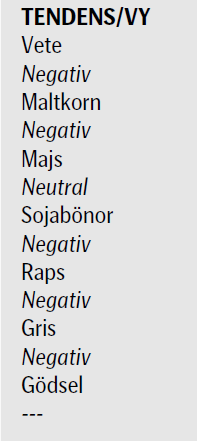 Europa ser inte bättre ut. Tyskland hade tänkt emittera nya obligationer igår, men mer än en tredjedel av dem blev kvar. Det berodde inte på att priset blev fel. Spararna var helt enkelt ointresserade. Under tiden ligger Italiens 10-årsränta kvar på samma höga nivå som före premiärministerbytet, Frankrikes ränta fortsätter stiga och Spaniens (”too big to save”) steg igår till 6.65%. Greklands ränta går inte att hitta längre i Bloomberg. ”Return on capital” är uppenbarligen ointressant. Det som visas är priset på statspapperen (lite drygt 20%), alltså ”return of capital”.
Europa ser inte bättre ut. Tyskland hade tänkt emittera nya obligationer igår, men mer än en tredjedel av dem blev kvar. Det berodde inte på att priset blev fel. Spararna var helt enkelt ointresserade. Under tiden ligger Italiens 10-årsränta kvar på samma höga nivå som före premiärministerbytet, Frankrikes ränta fortsätter stiga och Spaniens (”too big to save”) steg igår till 6.65%. Greklands ränta går inte att hitta längre i Bloomberg. ”Return on capital” är uppenbarligen ointressant. Det som visas är priset på statspapperen (lite drygt 20%), alltså ”return of capital”.
Ska vi sammanfatta, så ser det illavarslande ut. Konsumtionen ser ut att drabbas i USA, i Europa och i Kina. Om vi drar paralleller till 2008/09, så skulle vi kunna vänta oss att privat konsumtion håller i sig till Jul och sedan blir det tvärstopp. Jag kanske låter negativ, men situationen är verkligen mycket, mycket allvarlig i samhällshushållningen utanför jordbruksmarknaden.
Vete
Terminspriset på Matif-vete stängde på 179 euro för februarileverans. Som väntat har inte 180-euronivån hållit. Marknaden handlade under dagen ner vetet till 176.5 euro, men fyndköpare kom in och stängde onsdagen på 179. Detta är ändå en klar säljsignal.
Nedan ser vi terminskurvan för Chicagovete och Matif nu och för en vecka sedan. De ”feta” kurvorna är de aktuella. De ”smala” är förra veckans. Vi ser något av en tendens till särskilt lägre priser på längre Matif-terminer.
Förra gången vi såg backwardation i Europa var förra gången (2008) som priset föll. Då visade det sig att bönder satt kvar med vetet på gården i förhoppningen om att kunna sälja det dyrare – om bara priset ville gå upp igen. Kanske är det samma orsak till backwardation igen (brist, för att bönder inte säljer).
Om bönderna tror på högre priser och sitter kvar med vetet – sälj åtminstone spot dyrt och köp terminer billigare istället. Det är bättre. Men inte bra. Det här är en riktig ”bear market”. Priset kommer att falla. Det är ett klassiskt fall av rekommendationen ”Sell and go away. Come back in May.”
Etanol har blivit en viktig faktor, inte bara för majs i USA, utan även för vete i Europa. Europa och USA är två ganska osynkroniserade marknader. Skatter, tullar, kvoter och transportkostnader skapar ett samband i USA mellan majs och etanol och i Europa mellan vete och etanol. När foderefterfrågan kan väntas dämpas i Europa pga minskad konsumtion och ökat sparande, står etanoltillverkarnas efterfrågan på spannmål kvar som en viktig faktor.
Matif-kvarnvete vs Etanolsorten T2 FOB Rotterdam ser vi i diagrammet nedan. Just nu kostar vetet till ett ton etanol 491 euro och ett ton etanol 596, FOB Rotterdam. Marginalen är alltså 104 euro per ton etanol.
Som vi ser är detta en historiskt mycket god marginal. Etanolproducenternas intressen är alltså ett stöd i marknaden. Men notera att marginalen vi ser ovan inte är etanolproducenternas vinst. Kostnaderna utgörs även av bränsle, löner, räntor och avskrivningar, förstås.
Råoljepriset hålls högt – och extremt volatilt – eftersom produktionsreserverna (som kan tas i anspråk vid behov) är små. Så har det varit sedan ungefär 2005. Å ena sidan tycks vi stå inför en konjunkturnedgång. Å andra sidan befinner sig Syrien och Egypten i uppror i den rörelse som kallas ”den arabiska våren” och som skapar oro för att de små reserverna i oljeproduktionen inte ska räcka till om ett viktigare land än Libyen drabbas av krig.
Ryssland och Ukraina fortsätter att vinna exportordrar. Och europeiskt vete fortsätter att förlora tenders. I fredags förra veckan nåddes vi av det obekräftade ryktet att Algeriet (som köpt 100% från Frankrike alla år) köpt Argentinskt. Det finns ännu inga tecken på att Ryssland och Ukraina nått ”peak exports” för säsongen.
Allt talar för att Matif-vete faller ner i första hand till 150 – 160 – euro-nivån. På köparsidan hittar vi antagligen etanolfabrikanter.
Maltkorn
Maltkornsmarknaden följer vetet och det finns inga speciella nyheter att rapportera. Tekniskt ligger priset under glidande medelvärden. Den tekniska trenden är alltså nedåtriktad.
Potatis
Priset på potatis av årets skörd steg med 5% den senaste veckan, som en reaktion på förra veckans prisfall på 9%.
Nedan ser vi kursdiagrammet på europeisk potatis, som handlas på Eurex; terminen avser leverans april nästa år.
Majs
Majspriset har fallit till en teknisk stödnivå och frågan är nu om priset kommer att brytas. Vad som direkt talar för det är att dollarn har stärkts kraftigt mot europeiska valutor. Bara av den anledningen borde priset (i dollar) justeras ner.
I Argentina sker sådden just nu och det är relativt torrt. En förvärring av La Niña vore ”bullish news”, men den närmaste 14-dagarsprognosen innehåller en del regn, så än så länge ligger farhågorna i framtiden.
Nedan ser vi marskontraktet på CBOT, där priset ligger på den nivå vid 600 cent där marknaden funnit stöd flera gånger. Den här gången talar dock den starka dollarn för att stödet bryts och majs definitivt går in i en ”bear market”.
Sojabönor
Priset på sojabönor befinner sig i en sjunkande trend. Det är en ”bear market”. Denna förstärktes för ett par dagar sedan när det tekniska stödet på 1167 bröts. Priset kan mycket väl gå ner mot 10 dollar.
Brasilianska säljare lär komma in allt mer och sälja ner priset. Vi är negativa ur tekniskt perspektiv de närmaste tre månaderna.
Raps
Rapspriset håller sig högt pga den svaga euron, inget annat, skrev vi för en vecka sedan och det gäller än. Raps är dyrt i förhållande till sojabönor och ”borde” falla ner mot 400 euro i första hand.
Gris
Tekniskt vilar priset på lean hogs på de glidande medelvärdena. Priset håller sig högt, trots svaghet i alla andra marknader utom ädelmetaller. Det är orimligt och priset på gris borde gå ner det också.
Valutor
EURSEK handlas i ett volatilt brett intervall. Det finns inga signaler att utläsa alls. Kronan har försvagats och det är konstigt.
EURUSD har äntligen brutit nedåt och nu lär det gå fort.l. I första hand är nästa stöd 1.3145 dollar. I andra hand är det botten nere vid 1.2 dollar.
USDSEK stiger som förväntat när det skakar till i världen och lite extra förstås när det skakar till i EU (som Sverige är en del av). Nästa test är 7 kr och med det momentum marknaden har är valutakursen sannolikt där snart.
Gödsel
Kalium
Priset på kalium ligger kvar på samma nivå som för ett par veckor sedan.
Kväve
Nedan ser vi prisutvecklingen på Urea FOB Yuzhny i dollar per ton. Det har inte varit någon förändring.
Fosfor
Nedan ser vi prisutvecklingen på Diammoniumfosfat FOB Baltic i dollar per ton. Det har inte varit någon förändring från förra veckan.
[box]SEB Veckobrev Jordbruksprodukter är producerat av SEB Merchant Banking och publiceras i samarbete och med tillstånd på Råvarumarknaden.se[/box]
Disclaimer
The information in this document has been compiled by SEB Merchant Banking, a division within Skandinaviska Enskilda Banken AB (publ) (“SEB”).
Opinions contained in this report represent the bank’s present opinion only and are subject to change without notice. All information contained in this report has been compiled in good faith from sources believed to be reliable. However, no representation or warranty, expressed or implied, is made with respect to the completeness or accuracy of its contents and the information is not to be relied upon as authoritative. Anyone considering taking actions based upon the content of this document is urged to base his or her investment decisions upon such investigations as he or she deems necessary. This document is being provided as information only, and no specific actions are being solicited as a result of it; to the extent permitted by law, no liability whatsoever is accepted for any direct or consequential loss arising from use of this document or its contents.
About SEB
SEB is a public company incorporated in Stockholm, Sweden, with limited liability. It is a participant at major Nordic and other European Regulated Markets and Multilateral Trading Facilities (as well as some non-European equivalent markets) for trading in financial instruments, such as markets operated by NASDAQ OMX, NYSE Euronext, London Stock Exchange, Deutsche Börse, Swiss Exchanges, Turquoise and Chi-X. SEB is authorized and regulated by Finansinspektionen in Sweden; it is authorized and subject to limited regulation by the Financial Services Authority for the conduct of designated investment business in the UK, and is subject to the provisions of relevant regulators in all other jurisdictions where SEB conducts operations. SEB Merchant Banking. All rights reserved.
Analys
Brent crude ticks higher on tension, but market structure stays soft

Brent crude has climbed roughly USD 1.5-2 per barrel since Friday, yet falling USD 0.3 per barrel this mornig and currently trading near USD 67.25/bbl after yesterday’s climb. While the rally reflects short-term geopolitical tension, price action has been choppy, and crude remains locked in a broader range – caught between supply-side pressure and spot resilience.

Prices have been supported by renewed Ukrainian drone strikes targeting Russian infrastructure. Over the weekend, falling debris triggered a fire at the 20mtpa Kirishi refinery, following last week’s attack on the key Primorsk terminal.
Argus estimates that these attacks have halted ish 300 kbl/d of Russian refining capacity in August and September. While the market impact is limited for now, the action signals Kyiv’s growing willingness to disrupt oil flows – supporting a soft geopolitical floor under prices.
The political environment is shifting: the EU is reportedly considering sanctions on Indian and Chinese firms facilitating Russian crude flows, while the U.S. has so far held back – despite Bessent warning that any action from Washington depends on broader European participation. Senator Graham has also publicly criticized NATO members like Slovakia and Hungary for continuing Russian oil imports.
It’s worth noting that China and India remain the two largest buyers of Russian barrels since the invasion of Ukraine. While New Delhi has been hit with 50% secondary tariffs, Beijing has been spared so far.
Still, the broader supply/demand balance leans bearish. Futures markets reflect this: Brent’s prompt spread (gauge of near-term tightness) has narrowed to the current USD 0.42/bl, down from USD 0.96/bl two months ago, pointing to weakening backwardation.
This aligns with expectations for a record surplus in 2026, largely driven by the faster-than-anticipated return of OPEC+ barrels to market. OPEC+ is gathering in Vienna this week to begin revising member production capacity estimates – setting the stage for new output baselines from 2027. The group aims to agree on how to define “maximum sustainable capacity,” with a proposal expected by year-end.
While the IEA pegs OPEC+ capacity at 47.9 million barrels per day, actual output in August was only 42.4 million barrels per day. Disagreements over data and quota fairness (especially from Iraq and Nigeria) have already delayed this process. Angola even quit the group last year after being assigned a lower target than expected. It also remains unclear whether Russia and Iraq can regain earlier output levels due to infrastructure constraints.
Also, macro remains another key driver this week. A 25bp Fed rate cut is widely expected tomorrow (Wednesday), and commodities in general could benefit a potential cut.
Summing up: Brent crude continues to drift sideways, finding near-term support from geopolitics and refining strength. But with surplus building and market structure softening, the upside may remain capped.
Analys
Volatile but going nowhere. Brent crude circles USD 66 as market weighs surplus vs risk

Brent crude is essentially flat on the week, but after a volatile ride. Prices started Monday near USD 65.5/bl, climbed steadily to a mid-week high of USD 67.8/bl on Wednesday evening, before falling sharply – losing about USD 2/bl during Thursday’s session.

Brent is currently trading around USD 65.8/bl, right back where it began. The volatility reflects the market’s ongoing struggle to balance growing surplus risks against persistent geopolitical uncertainty and resilient refined product margins. Thursday’s slide snapped a three-day rally and came largely in response to a string of bearish signals, most notably from the IEA’s updated short-term outlook.
The IEA now projects record global oversupply in 2026, reinforcing concerns flagged earlier by the U.S. EIA, which already sees inventories building this quarter. The forecast comes just days after OPEC+ confirmed it will continue returning idle barrels to the market in October – albeit at a slower pace of +137,000 bl/d. While modest, the move underscores a steady push to reclaim market share and adds to supply-side pressure into year-end.
Thursday’s price drop also followed geopolitical incidences: Israeli airstrikes reportedly targeted Hamas leadership in Doha, while Russian drones crossed into Polish airspace – events that initially sent crude higher as traders covered short positions.
Yet, sentiment remains broadly cautious. Strong refining margins and low inventories at key pricing hubs like Europe continue to support the downside. Chinese stockpiling of discounted Russian barrels and tightness in refined product markets – especially diesel – are also lending support.
On the demand side, the IEA revised up its 2025 global demand growth forecast by 60,000 bl/d to 740,000 bl/d YoY, while leaving 2026 unchanged at 698,000 bl/d. Interestingly, the agency also signaled that its next long-term report could show global oil demand rising through 2050.
Meanwhile, OPEC offered a contrasting view in its latest Monthly Oil Market Report, maintaining expectations for a supply deficit both this year and next, even as its members raise output. The group kept its demand growth estimates for 2025 and 2026 unchanged at 1.29 million bl/d and 1.38 million bl/d, respectively.
We continue to watch whether the bearish supply outlook will outweigh geopolitical risk, and if Brent can continue to find support above USD 65/bl – a level increasingly seen as a soft floor for OPEC+ policy.
Analys
Waiting for the surplus while we worry about Israel and Qatar

Brent crude makes some gains as Israel’s attack on Hamas in Qatar rattles markets. Brent crude spiked to a high of USD 67.38/b yesterday as Israel made a strike on Hamas in Qatar. But it wasn’t able to hold on to that level and only closed up 0.6% in the end at USD 66.39/b. This morning it is starting on the up with a gain of 0.9% at USD 67/b. Still rattled by Israel’s attack on Hamas in Qatar yesterday. Brent is getting some help on the margin this morning with Asian equities higher and copper gaining half a percent. But the dark cloud of surplus ahead is nonetheless hanging over the market with Brent trading two dollar lower than last Tuesday.

Geopolitical risk premiums in oil rarely lasts long unless actual supply disruption kicks in. While Israel’s attack on Hamas in Qatar is shocking, the geopolitical risk lifting crude oil yesterday and this morning is unlikely to last very long as such geopolitical risk premiums usually do not last long unless real disruption kicks in.
US API data yesterday indicated a US crude and product stock build last week of 3.1 mb. The US API last evening released partial US oil inventory data indicating that US crude stocks rose 1.3 mb and middle distillates rose 1.5 mb while gasoline rose 0.3 mb. In total a bit more than 3 mb increase. US crude and product stocks usually rise around 1 mb per week this time of year. So US commercial crude and product stock rose 2 mb over the past week adjusted for the seasonal norm. Official and complete data are due today at 16:30.
A 2 mb/week seasonally adj. US stock build implies a 1 – 1.4 mb/d global surplus if it is persistent. Assume that if the global oil market is running a surplus then some 20% to 30% of that surplus ends up in US commercial inventories. A 2 mb seasonally adjusted inventory build equals 286 kb/d. Divide by 0.2 to 0.3 and we get an implied global surplus of 950 kb/d to 1430 kb/d. A 2 mb/week seasonally adjusted build in US oil inventories is close to noise unless it is a persistent pattern every week.
US IEA STEO oil report: Robust surplus ahead and Brent averaging USD 51/b in 2026. The US EIA yesterday released its monthly STEO oil report. It projected a large and persistent surplus ahead. It estimates a global surplus of 2.2 m/d from September to December this year. A 2.4 mb/d surplus in Q1-26 and an average surplus for 2026 of 1.6 mb/d resulting in an average Brent crude oil price of USD 51/b next year. And that includes an assumption where OPEC crude oil production only averages 27.8 mb/d in 2026 versus 27.0 mb/d in 2024 and 28.6 mb/d in August.
Brent will feel the bear-pressure once US/OECD stocks starts visible build. In the meanwhile the oil market sits waiting for this projected surplus to materialize in US and OECD inventories. Once they visibly starts to build on a consistent basis, then Brent crude will likely quickly lose altitude. And unless some unforeseen supply disruption kicks in, it is bound to happen.
US IEA STEO September report. In total not much different than it was in January
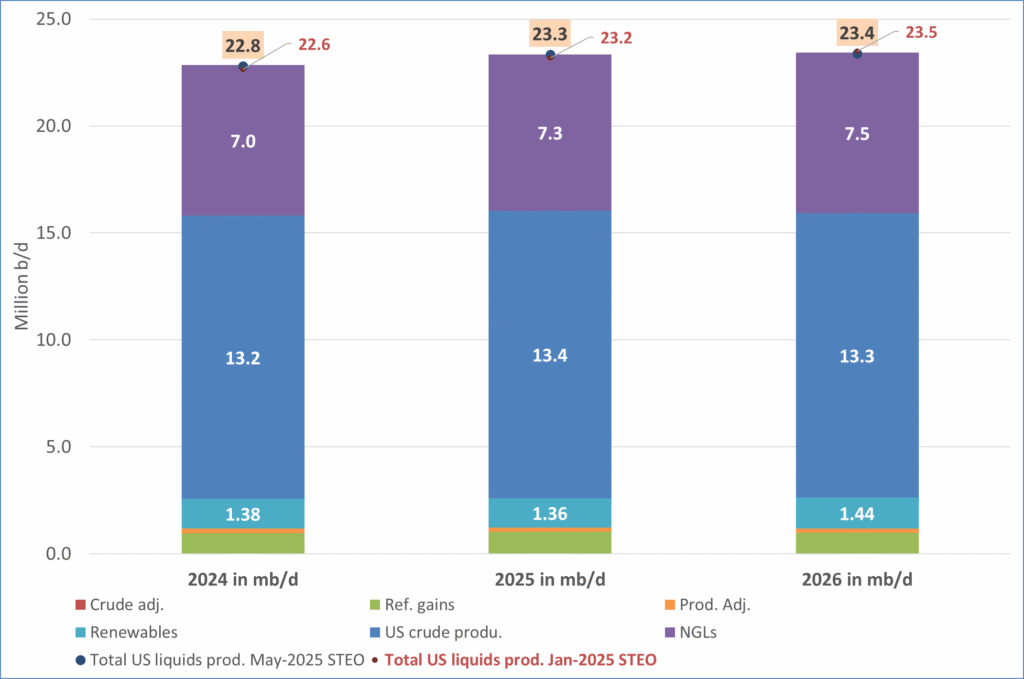
US IEA STEO September report. US crude oil production contracting in 2026, but NGLs still growing. Close to zero net liquids growth in total.
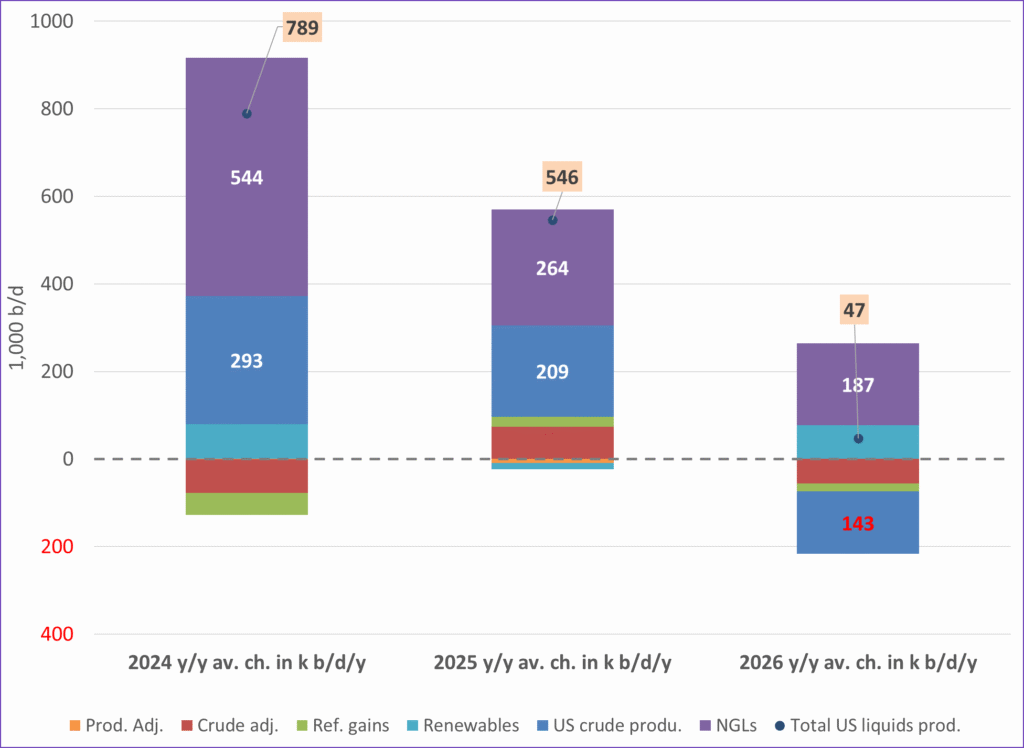
-

 Nyheter4 veckor sedan
Nyheter4 veckor sedanMeta bygger ett AI-datacenter på 5 GW och 2,25 GW gaskraftverk
-
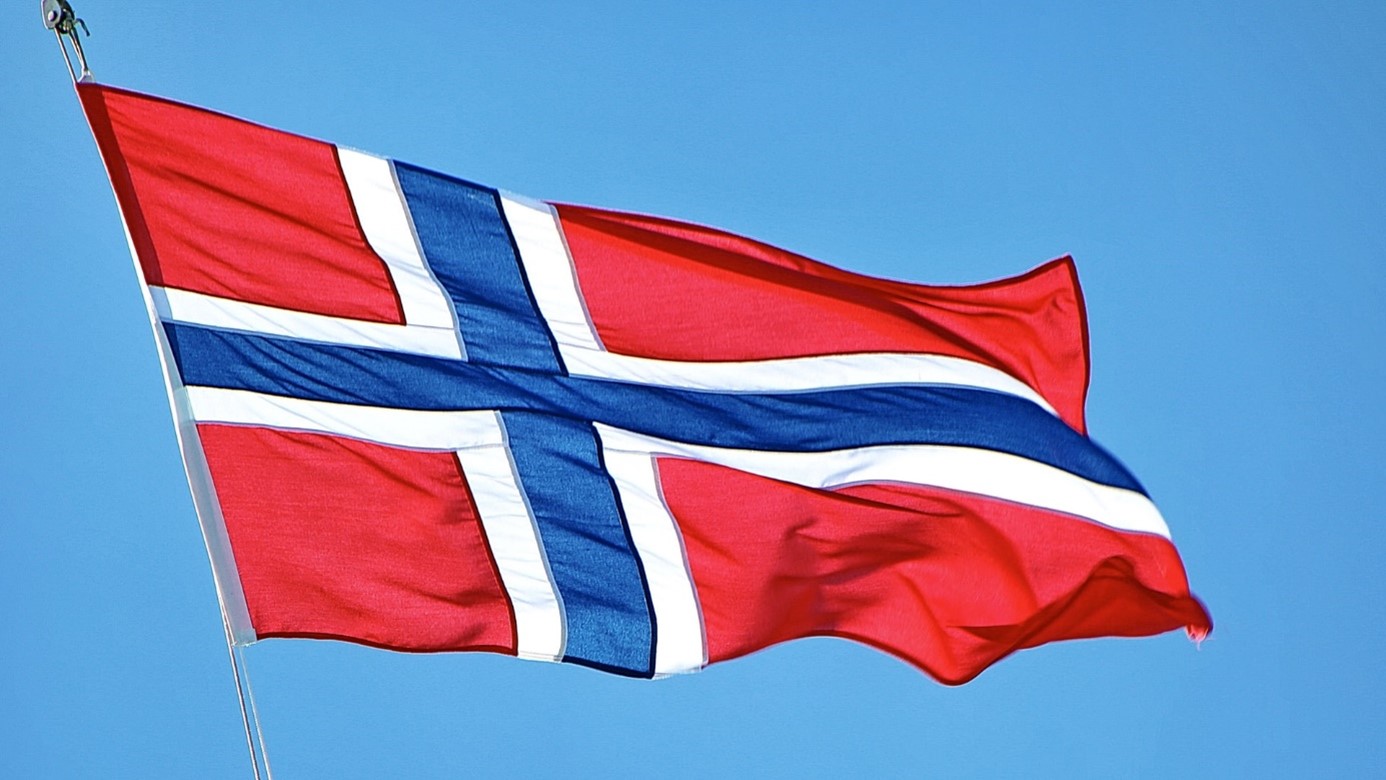
 Nyheter4 veckor sedan
Nyheter4 veckor sedanAker BP gör ett av Norges största oljefynd på ett decennium, stärker resurserna i Yggdrasilområdet
-

 Analys4 veckor sedan
Analys4 veckor sedanBrent edges higher as India–Russia oil trade draws U.S. ire and Powell takes the stage at Jackson Hole
-
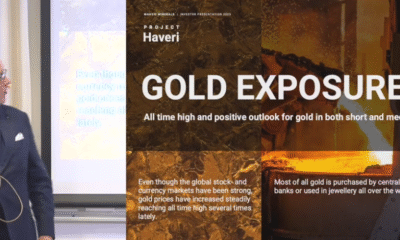
 Nyheter3 veckor sedan
Nyheter3 veckor sedanMahvie Minerals är verksamt i guldrikt område i Finland
-

 Analys4 veckor sedan
Analys4 veckor sedanIncreasing risk that OPEC+ will unwind the last 1.65 mb/d of cuts when they meet on 7 September
-

 Nyheter4 veckor sedan
Nyheter4 veckor sedanNeil Atkinson spår att priset på olja kommer att stiga till 70 USD
-

 Nyheter2 veckor sedan
Nyheter2 veckor sedanEurobattery Minerals satsar på kritiska metaller för Europas självförsörjning
-

 Analys2 veckor sedan
Analys2 veckor sedanOPEC+ in a process of retaking market share


